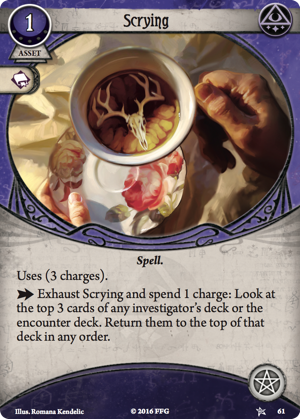Most likely you don't have to read this review to know how powerful Scrying is.
Everyone who played The Lord of the Rings LCG by Fantasyflight games over the last years knows what nasty stuff the encounter deck will throw at you to ruin your game and the same goes for Arkham Horror. (Everybody who got busted up by Umôrdhoth's Wrath please raise your hand.)
So just like in LotR LCG, cards with an "encounter deck manipulation" effect are very powerful. There are different forms of encounter deck manipulation. Some examples are:
- cards that simply cancel the effects of a drawn encounter deck card
- cards that let you know what the next draw(s) from the encounterdeck will bring
- cards that let you move cards within the encounter deck..
Scrying let's you do the latter 2 things. Knowing that a very nasty thing will happen in 3 rounds (or that it won't happen) makes it a lot easier to plan ahead and decide what cards to play or to keep in hand. "Burying" a particular nasty enemy or threachery to delay it being drawn for like 8 rounds and at the same time controlling in what order the next 8 cards from the encounter deck will be drawn is even stronger.
After using Scrying, you know its safe when to to play Drawn to the Flame, because you plan using it knowing that you will draw Obscuring Fog at a location with no more clues on it. Or you can just prevent Umôrdhoth's Wrath coming into play for a lot of rounds. And as a cherry on top, Scrying let's you take a look and order the next 3 cards in the investigator deck too.
For me, Scrying is an almost auto-include for every investigator whose deck building rules will permit me to use it... IF I'm playing solo. Due to the fact that more players means more draws from the encounter deck each round, Scrying sadly loses a lot of its power in multiplayer games. If the team of investigators has to draw 2-4 cards from the encounter deck each round, Scrying just can't keep up. In solo-play however, this will be a card that we will be still using for years to come.
